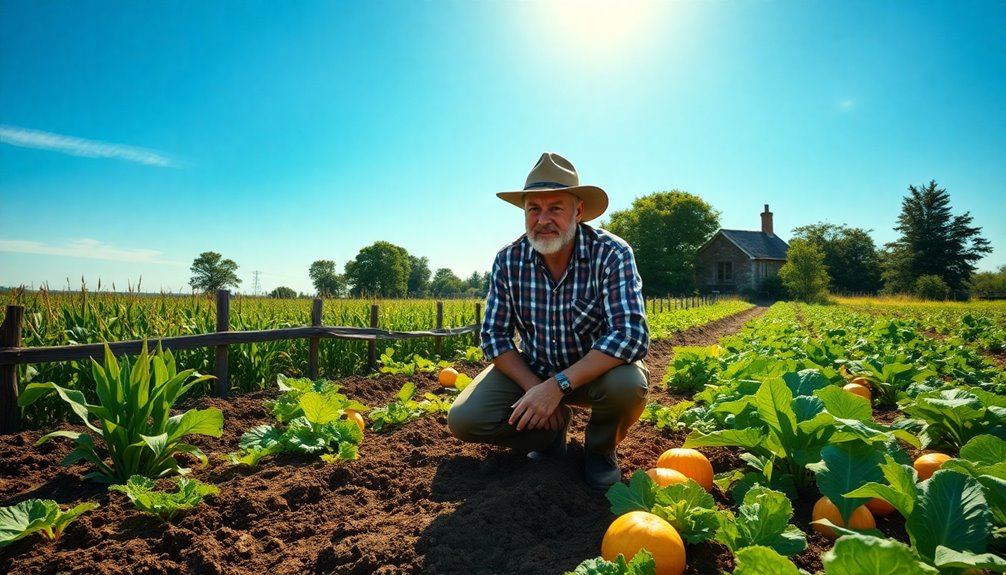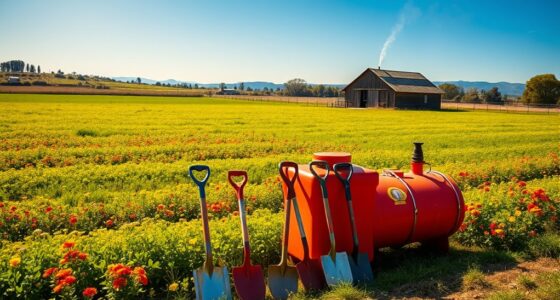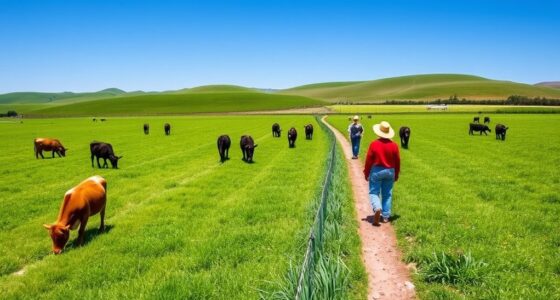Subsistence farming's your gateway to mastering self-sufficient agriculture. This practice focuses on producing food primarily for personal consumption, often with little surplus for sale. You'll typically work with small plots of land, employing traditional techniques that emphasize crop diversity. This approach not only guarantees food security but also strengthens community bonds and cultural identity. While it's prevalent in rural areas across developing countries, subsistence farming faces challenges like climate impact and limited resources. If you want to explore the intricacies and benefits of this sustainable practice, there's much more to uncover about its significance and techniques.
Key Takeaways
- Subsistence farming focuses on producing food primarily for personal consumption, minimizing surplus for sale or trade.
- It typically involves small plots of land, promoting crop diversity for enhanced food security.
- Traditional farming methods and local resources are central to subsistence farming practices.
- The approach often fosters community bonds and cultural identity through shared agricultural activities.
- Despite its benefits, subsistence farming faces challenges like climate change, resource access, and market vulnerability.
Definition and Characteristics
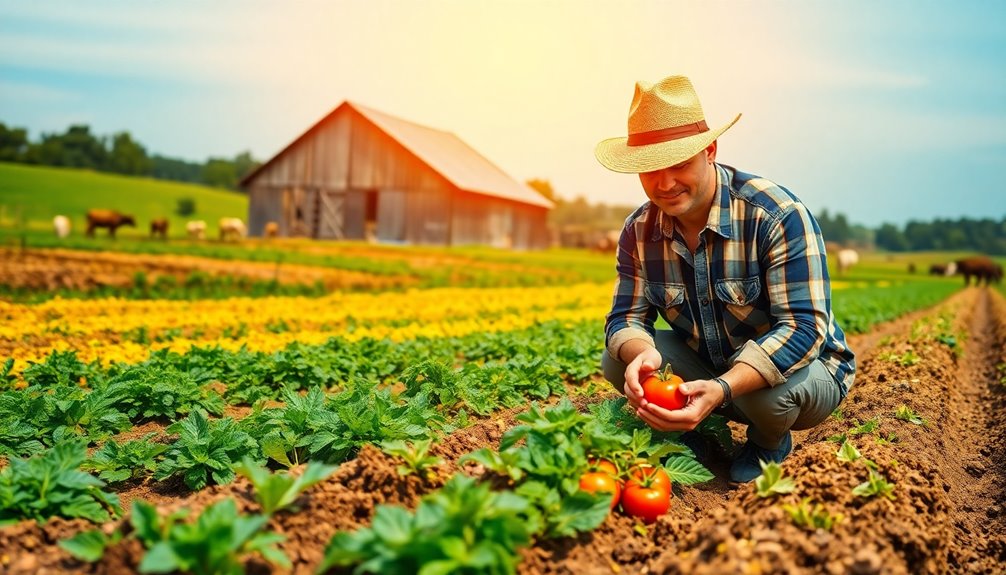
Subsistence farming is primarily about growing food for your own consumption, with only a small amount left over for sale or trade.
You typically work with small plots of land, often just a few acres, using traditional farming methods that rely on local resources. This approach emphasizes crop diversity, ensuring food security for your family despite the challenges of low yields and limited use of agrochemicals.
Mainly practiced in rural areas of developing countries, subsistence farming thrives in regions like sub-Saharan Africa, parts of Asia, and Latin America, where access to markets is limited.
Historical Context
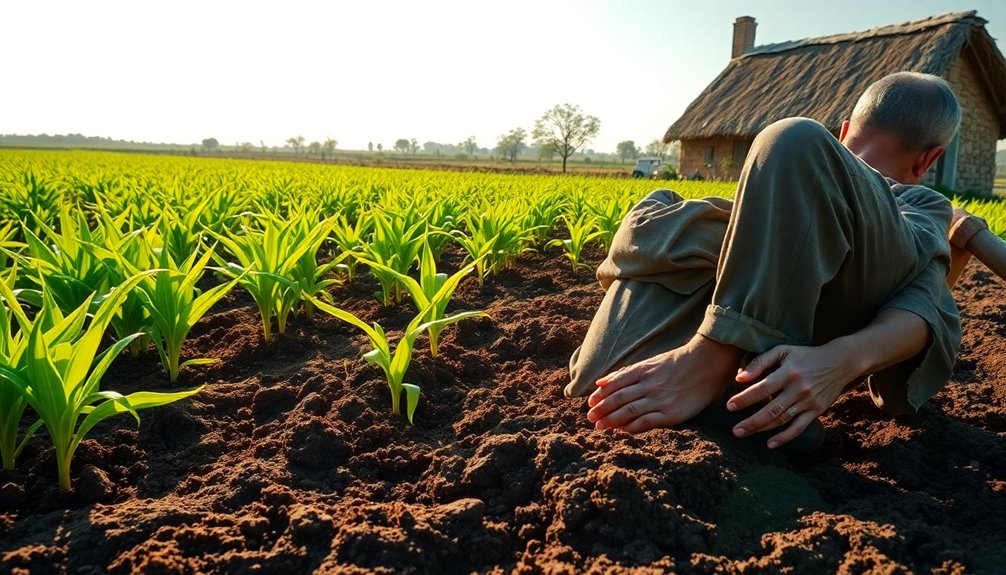
Agriculture as we perceive it began over 12,000 years ago during the Neolithic Revolution, shifting societies from hunting and gathering to farming. Subsistence farming became the backbone of rural areas, where families relied on their agricultural production to meet basic needs.
They cultivated diverse crops and raised livestock to guarantee self-sufficiency, especially in regions with limited market access.
As urban populations grew, the demand for food led to a change towards commercial agriculture, altering traditional farming practices. This shift resulted in larger agribusiness operations but diminished community resilience, making many people economically dependent on market fluctuations.
- Historical reliance on local food sources
- Diverse crop cultivation for year-round supply
- Self-sufficiency as a survival strategy
- Decline of subsistence farming post-Market Revolution
- Impact on community connections and resources
Global Distribution
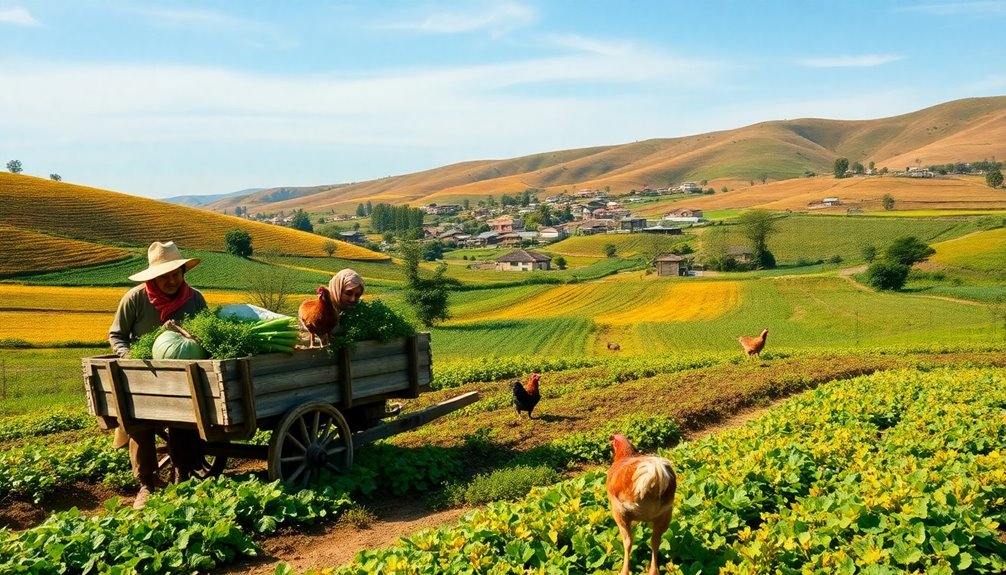
When you look at global distribution, you'll find that subsistence farming is most common in sub-Saharan Africa, where it dominates rural agriculture.
In places like India and China, a large majority of farmers practice it on small plots, while Latin American communities grow diverse crops shaped by their local cultures.
These practices vary widely due to differences in climate, resources, and traditions, highlighting the unique agricultural systems in each region.
Regions of Prevalence
In many regions around the world, subsistence farming plays an essential role in sustaining local communities and their economies. This practice is especially prevalent in:
- Sub-Saharan Africa, where it makes up about 70% of agriculture
- India, with around 80% of rural farmers engaged in small-scale farming
- China, where 98% of rural farmers rely on subsistence methods
- Latin America, where traditional agricultural practices support local food systems
- Remote areas with limited access to markets, ensuring food security
These diverse agricultural practices adapt to various climates and local conditions, helping families thrive despite climate change.
Subsistence farming not only provides sustenance but also strengthens rural communities and preserves cultural heritage.
Cultural Variations in Practices
Cultural variations in subsistence farming practices reflect the rich tapestry of human adaptation to diverse environments across the globe.
In sub-Saharan Africa, around 70% of the population relies on subsistence farming, while in Asia, countries like India and China see as much as 98% of rural farmers using traditional methods on small plots.
Latin American indigenous communities also cultivate crops for personal consumption, preserving their cultural heritage.
You'll find practices like shifting agriculture, which maintains soil fertility, and terrace farming, adapting to mountainous terrains.
These methods showcase diverse agricultural practices, often shaped by local climate and resources.
Ultimately, they enhance ecological sustainability, ensuring that communities thrive while honoring their ancestral agricultural practices.
Types of Subsistence Farming
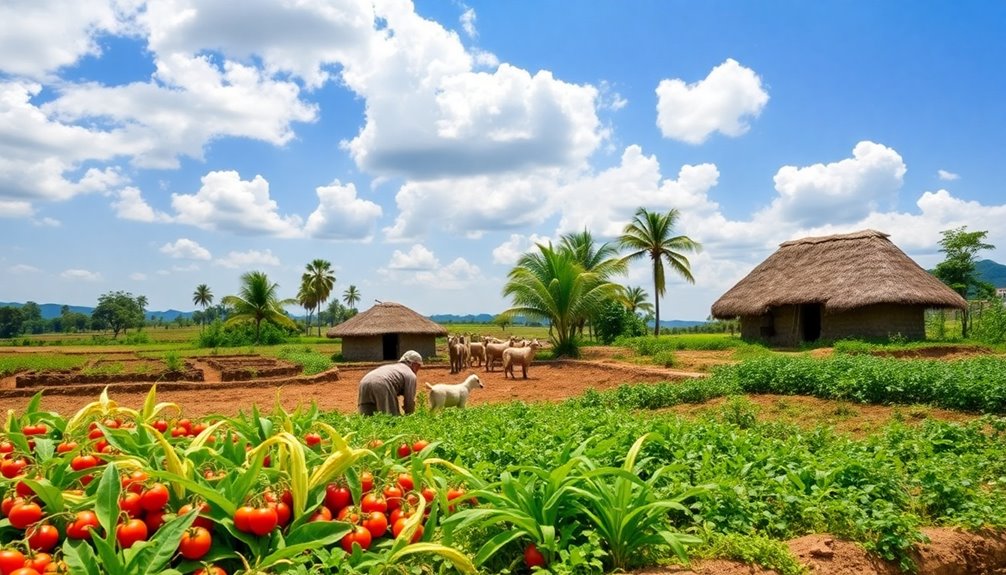
When you explore the types of subsistence farming, you'll encounter practices like shifting agriculture, intensive techniques, and polyculture.
Each method has its unique approach to land use and crop production, tailored to different environments and needs.
Understanding these types can give you insight into how communities sustain themselves through agriculture.
Shifting Agriculture Practices
Shifting agriculture, often referred to as slash-and-burn or swidden farming, represents a dynamic approach to subsistence farming that emphasizes the careful management of land and resources.
By clearing a patch of forest, you cultivate crops for a few years before moving on, allowing the soil fertility to recover. This method supports food security for rural communities while maintaining biodiversity and soil health.
- Typically involves rice, maize, or cassava
- Fields are rotated every 2-5 years
- Regeneration of land enhances sustainability
- Minimizes reliance on external agricultural inputs
- Faces challenges from deforestation and climate change
Embracing traditional practices, shifting agriculture can be a cornerstone of sustainable agriculture when managed wisely. Additionally, incorporating indigenous ingredients such as cassava can improve crop resilience and nutritional value.
Intensive Subsistence Techniques
Intensive subsistence farming is a crucial method that enables families to maximize their crop yields from limited land. By focusing on staple crops like rice, wheat, and maize, you can achieve food security despite high labor inputs.
Utilizing techniques such as crop rotation helps enhance soil fertility, reducing the risk of crop failure. This approach also encourages the diversification of crops, improving nutrition and bolstering local economies.
Many farmers in densely populated regions rely on organic fertilizers and traditional pest control methods, which maintain ecological balance while minimizing dependency on external inputs.
Polyculture and Intercropping
Building on the principles of intensive subsistence farming, polyculture and intercropping offer innovative ways to optimize land use and enhance food production. By growing multiple crops in the same space, you can improve soil fertility and reduce risks associated with pests and diseases.
Subsistence farmers often use intercropping, planting two or more crops together to maximize yields, sometimes achieving up to 30% increases compared to monoculture methods.
- Enhances biodiversity
- Supports diverse diets
- Reduces reliance on chemical fertilizers
- Improves food security
- Creates resilient farming systems
These techniques not only provide nutritious food but also contribute to sustainable agriculture, making them essential for communities facing climate unpredictability.
Embracing polyculture and intercropping can greatly benefit your farming practices.
Economic Impact
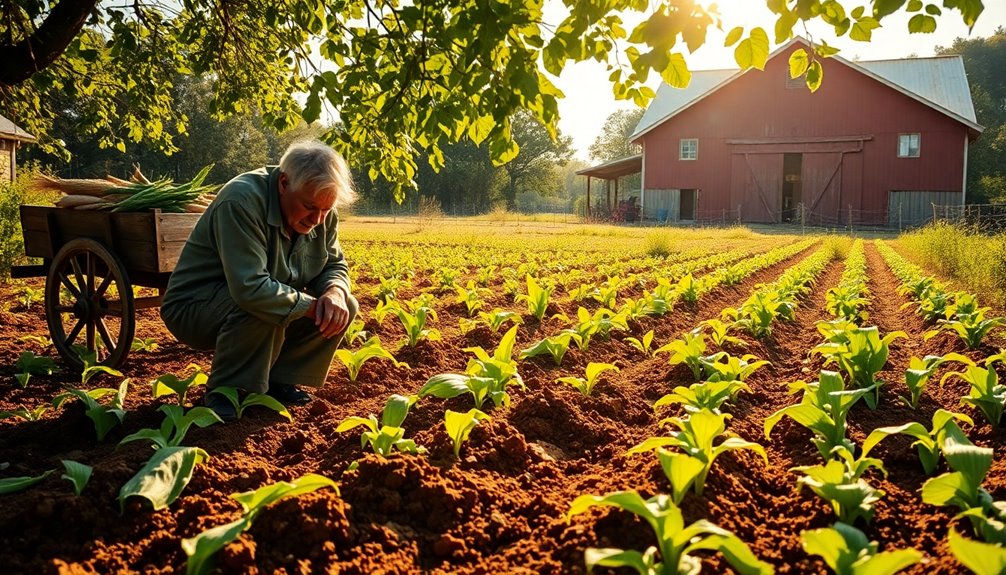
In many rural areas, subsistence farming plays an essential role in shaping local economies and livelihoods. This economic system provides food security and self-sufficiency for over 70% of rural populations in regions like sub-Saharan Africa.
However, it generates minimal cash flow due to limited surplus production, restricting economic opportunities for farmers and their families. Barter systems often come into play, enabling direct trading of goods and services, which strengthens local economies.
Yet, the vulnerability to climate change and environmental degradation poses significant challenges, hindering productivity and income potential. By addressing these issues, communities can enhance their resilience and improve their overall economic stability, ultimately fostering a more sustainable future for subsistence farmers.
Cultural Significance
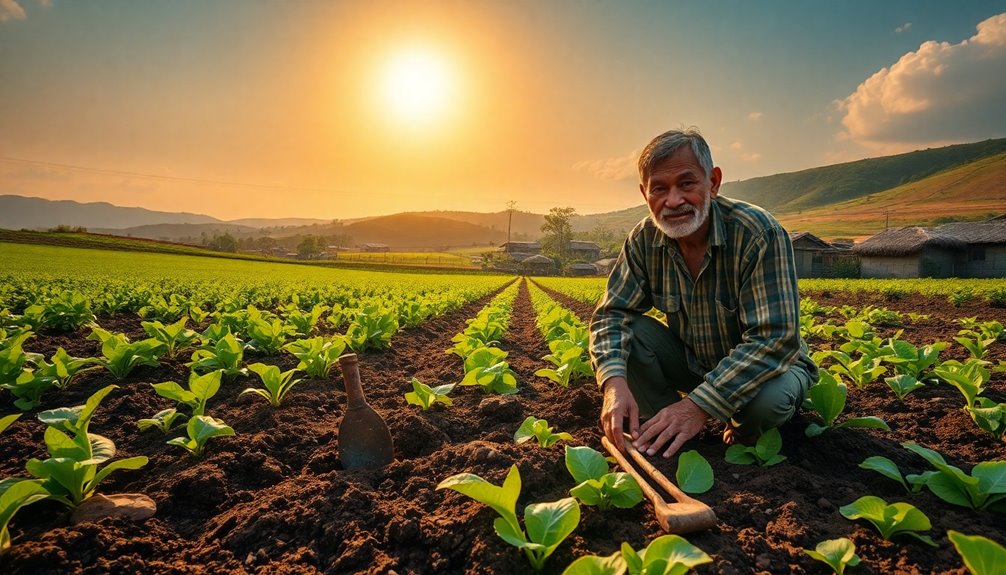
How does subsistence farming shape cultural identity? Subsistence farming often fosters a strong connection to the land, embedding cultural heritage into the daily lives of communities. By relying on local resources and traditional knowledge, you not only preserve agricultural practices but also promote food sovereignty and resilience.
- Strengthens community spirit through communal farming practices
- Maintains biodiversity by cultivating diverse crops
- Celebrates agricultural cycles with harvest festivals
- Reinforces social bonds during planting and harvesting
- Empowers families to pass down traditions through generations
These elements intertwine to create a rich tapestry of cultural significance, showcasing how subsistence farming helps you and your community thrive while honoring your roots. Additionally, the practice fosters a sense of personal growth as individuals learn to adapt and innovate in their agricultural methods.
Key Techniques and Practices
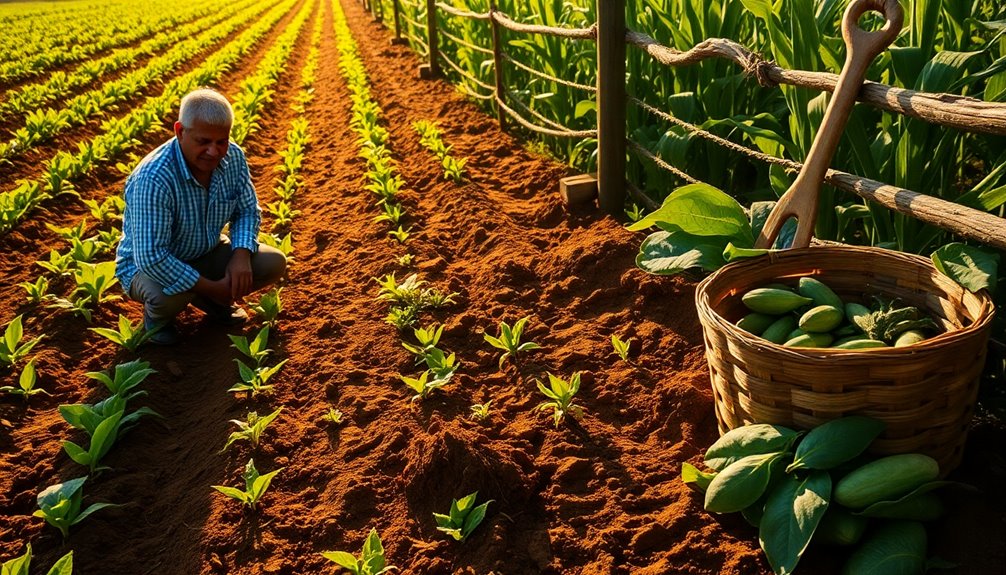
Subsistence farming relies on a variety of key techniques and practices that enhance productivity and sustainability.
To maintain soil fertility, you can implement crop rotation, preventing nutrient depletion in your small plots. Using polyculture, where you plant multiple crops together, boosts biodiversity and reduces the risk of total crop failure from pests or diseases.
Agroforestry, which integrates trees and shrubs into your farming system, improves soil health and provides additional food sources while supporting wildlife habitats. Rainwater harvesting techniques help you collect and store water for dry seasons, promoting sustainable water management.
Additionally, traditional knowledge passed down through generations enables you to adapt your practices to local conditions, enhancing resilience and sustainability in your subsistence farming efforts.
Benefits and Advantages
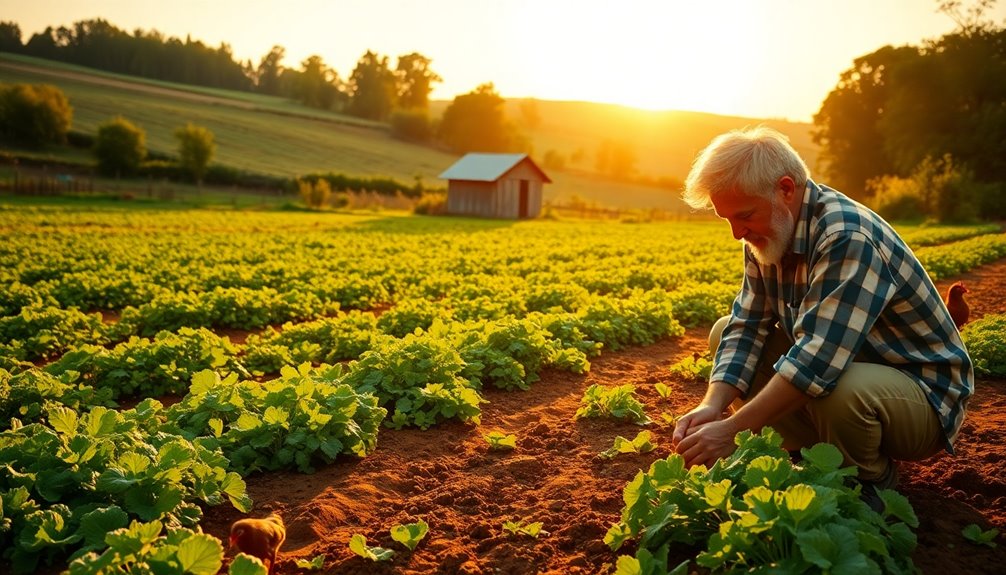
A significant advantage of subsistence farming is that it guarantees food security for families, providing a dependable source of nutrition while reducing reliance on external food markets.
This practice also fosters sustainable agricultural practices, benefiting both the environment and communities.
Here are some key benefits you might appreciate:
- Promotes crop diversity, enhancing resilience against pests and diseases
- Supports biodiversity by cultivating various crops
- Encourages economic independence through local resource utilization
- Reinforces community bonds during planting and harvesting
- Maintains soil health through organic farming methods
Challenges and Issues
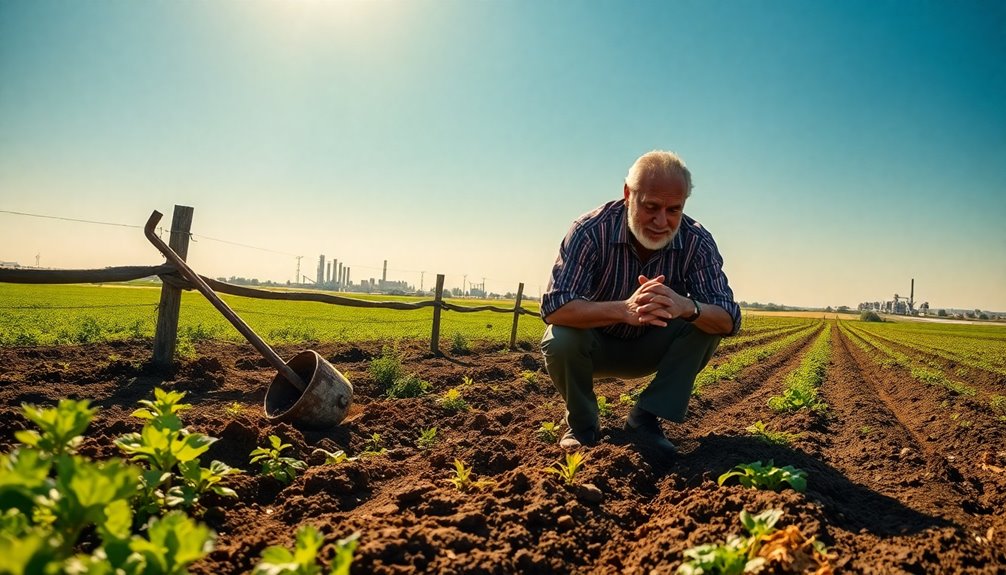
Many farmers face significant challenges in subsistence farming that can hinder their ability to sustain their livelihoods.
Subsistence farmers often struggle with limited access to resources, such as modern tools and quality seeds, which leads to low productivity levels. Additionally, they're vulnerable to climate change, facing unpredictable weather and natural disasters that threaten their crops.
Market access is another hurdle; many farmers find it difficult to sell surplus produce, restricting their economic potential. Insecure land rights further complicate their situation, as potential displacement can undermine their stability and community ties.
These issues collectively hinder progress towards food security, trapping subsistence farmers in cycles of poverty that are hard to break.
Frequently Asked Questions
What Is a Simple Definition of Subsistence Farming?
Subsistence farming is when you grow food mainly for your own consumption, rather than for selling.
You typically work with a small plot of land, utilizing traditional farming methods that often don't produce much surplus.
This approach helps you guarantee that you and your family have enough to eat without relying on external markets.
Common crops include staples like rice and maize, along with some livestock for added nutrition.
It's all about self-sufficiency.
What Is Subsistence Agriculture Best Defined As?
Imagine you're in a rural village, where families grow just enough food to feed themselves.
That's what subsistence agriculture is all about. It's best defined as a farming system where you primarily cultivate crops to meet your household needs, with little left over for selling.
You'd likely rely on traditional methods and local resources, focusing on a variety of staples like maize or rice to guarantee your family's food security year-round.
What Is Self Sufficient Agriculture?
Self-sufficient agriculture is all about growing what you need to feed yourself and your family without relying on outside sources.
You cultivate a variety of crops and raise livestock, ensuring a balanced diet. By using traditional techniques like crop rotation and intercropping, you maintain soil health and boost productivity.
This method is often practiced in rural areas, helping you achieve food security and sustainability in your community.
It's a rewarding way to live!
What Is the Biggest Problem With Subsistence Farming?
The biggest problem with subsistence farming is the low yields you often get from outdated techniques. This leaves you and your family vulnerable to food insecurity, making it tough to meet nutritional needs.
Climate change adds to the challenge, with unpredictable weather leading to crop failures. You're also hindered by limited access to modern tools and resources, and insecure land rights make it even harder to maintain a stable livelihood.
Conclusion
So, while you're busy scrolling through your latest online shopping spree, remember those brave souls practicing subsistence farming. They're out there, sweating over their tiny plots, living off what they can grow, all while you're wondering if you need that fifth pair of shoes. Isn't it charming that in a world of excess, some still find joy in dirt and seeds? Let's raise a glass to their self-sufficiency—after all, who needs to be fully fed when you've got a credit card?

